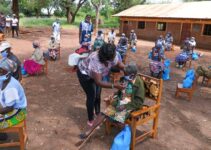You know, improving remote Canadian community healthcare policies is like building a sturdy bridge over rough waters. It's about creating a strong foundation to support the health and well-being of those in isolated areas. By addressing challenges in access, indigenous health disparities, and healthcare infrastructure, we can build a more resilient system. Telemedicine and better resource allocation can help bridge the gap, while addressing professional shortages and cultural competency is essential. Together, we can ensure that everyone, regardless of location, receives the care they deserve.
Key Takeaways
- Enhancing healthcare technology and infrastructure is crucial for improving access to remote patient care and bridging the gap between remote and urban healthcare services.
- Addressing healthcare professional shortages by recruiting and incentivizing healthcare professionals to work in remote areas is essential for ensuring adequate healthcare access in remote communities.
- Funding and resource allocation should be prioritized for essential healthcare services, telehealth technologies, and healthcare workforce recruitment and retention initiatives in remote areas.
- Community engagement and empowerment in shaping healthcare policies, as well as prioritizing cultural sensitivity and Indigenous representation, are necessary for addressing the unique needs and challenges of Indigenous peoples in remote areas.
Challenges in Remote Healthcare Access
You face significant challenges in accessing remote healthcare services in Canadian communities. The vast geographical expanse of Canada often leads to limited healthcare access for those living in remote areas. However, improving technology has the potential to bridge this gap and enhance healthcare access for individuals in these communities. With advancements in telemedicine and digital health records, you can now connect with healthcare professionals without having to travel long distances. These technological improvements not only save time and effort but also ensure that you receive timely and efficient healthcare services.
Furthermore, the integration of mobile health clinics and telehealth initiatives can bring essential medical resources directly to your community, making healthcare more accessible than ever before. By leveraging technology, healthcare providers can remotely monitor patients with chronic illnesses, provide consultations, and even offer diagnostic services. These advancements not only improve healthcare access but also contribute to better health outcomes for individuals in remote Canadian communities. Embracing and expanding these technological solutions is essential for overcoming the challenges associated with accessing healthcare in such remote areas.
Indigenous Health Policy Disparities
You need to address the policy gaps that contribute to the disparities in Indigenous health care. Culturally sensitive healthcare practices are essential to improving the overall well-being of Indigenous communities. It's crucial to prioritize community-driven policy solutions to ensure that the unique needs of Indigenous populations are met.
Addressing Policy Gaps
Addressing the policy gaps in Indigenous health policy disparities is crucial for improving remote Canadian community healthcare. To evoke emotion and urgency in the audience, consider the following:
- Indigenous communities continue to face barriers in accessing culturally appropriate healthcare services, perpetuating health disparities.
- Inadequate policy implementation has led to a lack of sustainable healthcare resources and infrastructure in remote Indigenous communities.
- The absence of meaningful community engagement in policy development has resulted in healthcare services that do not align with the unique needs and cultural context of Indigenous peoples.
- Policy gaps contribute to the ongoing trauma and intergenerational effects of colonialism on Indigenous health, demanding immediate attention and action for meaningful change.
Culturally Sensitive Healthcare
Improving remote Canadian community healthcare policies requires implementing culturally sensitive strategies to address Indigenous health policy disparities. Cultural sensitivity in healthcare involves recognizing and respecting the beliefs, values, and practices of Indigenous communities. It also involves promoting Indigenous representation in healthcare decision-making processes and ensuring that healthcare services are tailored to meet the unique cultural and linguistic needs of Indigenous peoples. Without culturally sensitive healthcare policies, there is a risk of perpetuating existing health disparities and failing to provide effective care to Indigenous communities. By prioritizing cultural sensitivity and Indigenous representation in healthcare policies, it becomes possible to bridge the gaps in healthcare access and outcomes for remote Canadian communities. Now, let's delve into community-driven policy solutions to further enhance healthcare accessibility and quality.
Community-Driven Policy Solutions
To tackle Indigenous health policy disparities in remote Canadian communities, prioritize community engagement and empowerment in shaping healthcare policies. This approach fosters policy collaboration and ensures that the community's unique needs and perspectives are considered. By actively involving community members in policy development, you can create solutions that are culturally sensitive and relevant to their lived experiences. This not only promotes a sense of ownership and trust but also empowers the community to take an active role in improving their own healthcare outcomes. Through genuine and respectful engagement, policies can be tailored to address the specific health challenges faced by Indigenous peoples in remote areas. This collaborative effort strengthens the bond between healthcare providers and the community, fostering a more effective and inclusive healthcare system.
- Empowerment: Engaging the community instills a sense of empowerment and ownership.
- Trust: Building trust through collaboration can lead to more effective policy implementation.
- Cultural relevance: Incorporating indigenous perspectives ensures culturally relevant healthcare policies.
- Inclusivity: Involving the community fosters a more inclusive and representative policy framework.
Telemedicine and Remote Consultations
When providing healthcare in remote Canadian communities, it is important to utilize telemedicine and remote consultations to improve access to medical care. Remote patient monitoring and virtual care solutions play a crucial role in ensuring that individuals in these communities have access to timely and effective healthcare services. Through telemedicine, healthcare providers can remotely monitor patients' vital signs, symptoms, and health data, allowing for proactive management of chronic conditions and early intervention in case of any concerning developments. Additionally, virtual care solutions enable healthcare professionals to conduct remote consultations, provide medical advice, and even offer certain treatments without the need for patients to travel long distances to access healthcare facilities. This not only enhances convenience for the residents of remote communities but also reduces the burden on already limited healthcare resources in these areas.
| Benefits of Telemedicine and Remote Consultations |
|---|
| Improved access to medical care |
| Proactive management of chronic conditions |
| Timely intervention in case of concerning developments |
| Enhanced convenience for residents of remote communities |
Healthcare Infrastructure in Remote Areas
How can you assess the current state of healthcare infrastructure in remote Canadian areas? It's essential to understand the challenges and opportunities in these regions.
- Access to healthcare technology in remote areas can be limited, hindering the delivery of efficient remote patient care.
- Inadequate healthcare infrastructure can lead to delayed diagnoses and treatments, impacting the well-being of remote communities.
- The lack of proper facilities and equipment might result in patients having to travel long distances for essential medical services.
- Insufficient healthcare infrastructure can also contribute to disparities in healthcare access and outcomes between remote and urban areas.
Understanding the current state of healthcare infrastructure in remote Canadian areas is crucial for identifying areas that need improvement. By focusing on enhancing healthcare technology and infrastructure, we can ensure better access to remote patient care. Addressing these challenges will be key to improving the overall healthcare policies for these communities and bridging the gap between remote and urban healthcare services. Now, let's delve into the next crucial aspect: addressing healthcare professional shortages.
Addressing Healthcare Professional Shortages
You need to focus on recruiting healthcare professionals to remote areas and incentivizing rural healthcare placements to address the shortages. By actively seeking out qualified individuals and providing attractive incentives, you can help ensure that these communities have the healthcare professionals they need. Encouraging professionals to consider working in remote areas through various means can help bridge the gap in healthcare services.
Recruiting Remote Healthcare Professionals
Where can remote Canadian communities find the necessary healthcare professionals to address shortages in their healthcare system?
- Remote healthcare recruitment can be challenging, but it is not impossible.
- Healthcare workforce shortages are a reality in many remote communities, leading to inadequate healthcare access.
- It's crucial to attract professionals who are passionate about making a difference in underserved areas.
- Offering competitive salaries and benefits is essential to entice healthcare workers to remote locations.
Transitioning into the subsequent section about 'incentivizing rural healthcare placements', it is vital to explore strategies that can make remote healthcare positions more appealing for professionals.
Incentivizing Rural Healthcare Placements
To address healthcare professional shortages in remote Canadian communities, incentivizing rural healthcare placements can be a crucial strategy for attracting and retaining qualified professionals. Financial incentives play a significant role in rural recruitment, as they can offset the challenges and costs associated with practicing in remote areas. Offering competitive salaries, signing bonuses, student loan repayment programs, and relocation assistance are effective ways to entice healthcare professionals to work in underserved areas. Additionally, providing opportunities for professional development, mentorship programs, and a supportive work environment can make rural placements more appealing. By implementing these incentives, healthcare organizations can cultivate a sustainable workforce in remote Canadian communities, ultimately improving access to quality care for residents in these underserved areas.
Funding and Resource Allocation
Consider allocating financial resources strategically to ensure equitable access to healthcare services in remote Canadian communities. Funding challenges and resource allocation disparities have long hindered the delivery of quality healthcare in these areas. To address these issues effectively, it is essential to:
- Prioritize funding for essential healthcare services such as primary care, mental health support, and chronic disease management to meet the unique needs of remote communities.
- Allocate resources for telehealth technologies to bridge the gap between remote communities and specialized healthcare providers, ensuring timely access to expert care.
- Implement targeted funding for healthcare workforce recruitment and retention initiatives in remote areas to address staffing shortages and improve access to care.
- Establish transparent resource allocation frameworks that consider the specific healthcare needs and challenges of remote communities, striving for fairness and equity in resource distribution.
Cultural Competency in Healthcare Delivery
Developing cultural competency in healthcare delivery is crucial for meeting the diverse needs of remote Canadian communities. In these communities, cultural awareness plays a significant role in providing effective healthcare services. It is essential for healthcare providers to understand and respect the cultural beliefs, values, and practices of the communities they serve. By doing so, healthcare professionals can build trust and rapport with patients, leading to improved health outcomes.
Language barriers also pose a significant challenge in healthcare delivery within remote Canadian communities. Healthcare providers must address these barriers by ensuring access to interpretation services or employing staff who can communicate effectively in the languages spoken within the community. This not only facilitates better understanding between healthcare providers and patients but also ensures that crucial medical information is accurately conveyed and understood.
Frequently Asked Questions
How Does the Geographic Isolation of Remote Canadian Communities Impact the Delivery of Healthcare Services?
Geographic isolation in remote Canadian communities impacts healthcare delivery by creating challenges in accessing medical resources. Limited infrastructure and long distances can lead to delays in receiving care, exacerbating healthcare disparities. Healthcare professionals may also face difficulties in reaching these areas, affecting the availability of services. Overall, the geographic isolation of remote Canadian communities presents significant obstacles in delivering timely and equitable healthcare to residents.
What Specific Cultural and Historical Factors Contribute to the Disparities in Indigenous Health Policies in Remote Areas?
You wonder how specific cultural and historical factors contribute to the disparities in indigenous health policies in remote areas. Cultural resilience and historical trauma play significant roles in shaping these disparities. The intergenerational impact of colonization, loss of traditional practices, and systemic discrimination have created barriers to accessing quality healthcare. Acknowledging and addressing these factors is crucial for developing effective policies that support the health and well-being of indigenous communities in remote areas.
How Do Remote Consultations Through Telemedicine Address the Unique Healthcare Needs of Indigenous Communities?
When it comes to addressing the unique healthcare needs of indigenous communities, remote consultations through telemedicine offer significant benefits. This approach allows healthcare providers to deliver culturally sensitive care while overcoming geographical barriers. Telemedicine benefits include improved access to specialized care, reduced travel burdens, and increased cultural sensitivity through the use of indigenous languages and traditional healing practices. Overall, it helps bridge the gap in healthcare services for remote indigenous communities.
What Are the Specific Challenges in Building and Maintaining Healthcare Infrastructure in Isolated and Remote Areas of Canada?
Building and maintaining healthcare infrastructure in isolated and remote areas of Canada presents unique challenges. Geographic isolation creates barriers to accessing care, and delivering services becomes more difficult. Limited resources and staffing shortages can further strain the infrastructure. These challenges require innovative solutions and tailored policies to ensure that healthcare needs are met effectively in these remote communities.
What Strategies Are Being Implemented to Attract and Retain Healthcare Professionals in Remote Canadian Communities?
To attract professionals and retain the workforce in remote Canadian communities, various strategies are being implemented. These include offering incentives such as loan forgiveness, housing assistance, and professional development opportunities. Additionally, creating a supportive work environment, promoting work-life balance, and providing access to telemedicine and other innovative healthcare technologies are being prioritized. These efforts aim to address the unique challenges of practicing healthcare in isolated areas and improve the overall quality of care for residents.
Conclusion
So, there you have it – just a few simple steps and you can magically fix all the healthcare challenges facing remote Canadian communities. Easy, right? Well, not really. The reality is that improving healthcare policies in remote areas is a complex and ongoing process that requires dedication, resources, and a commitment to addressing systemic disparities. It's not a quick fix, but it's a necessary one for the health and well-being of all Canadians.



